After our delayed departure from Ternate (described in the previous post) 'Caledonian Sky' had sailed overnight towards the improbably-shaped island of Sulawesi, previously called 'Celebes' by the Portuguese explorers. Wikipedia has a brief 'primer' here with an interesting relief map.

Relief Map of Sulawesi (Wikipedia).
Arriving by sea
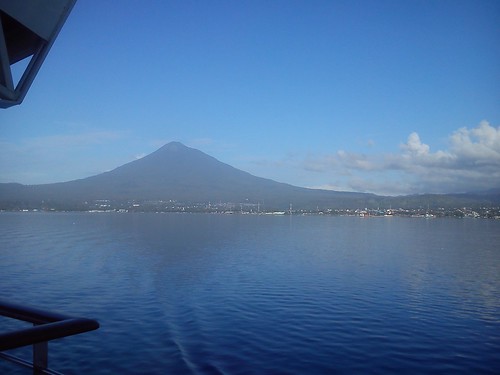 Bitung, viwed from 'Caledonian Sky'.
Bitung, viwed from 'Caledonian Sky'.
By half past six in the morning, we were approaching Bitung. Bitung lies at the north eastern tip of Sulawesi, on the eastern side of the promontory (see map above). The usual cone-shaped mountain lay in the background, this time with a second collapsed-cone mountain nearer the city. Clearly, Bitung was a location of some significance. Its population (I discovered later) was around 200,000. I believe Bitung became more important as a port after problems occured with silting at the port of Manado. Quays and the associated industries stretched along the shoreline for at least two miles. A Pilot boat delivered the Port Pilot to our ship for the final docking manoeuvres.
 Picking up the Pilot.
Picking up the Pilot.
As at Ternate, on our way in we passed numerous ships at anchor, some surprisingly large. As we neared the dock, we passed a couple of bulk carriers moored at the quay on our left. One had an electric crane mounted on a gantry on deck to make it self-unloading. Next, we passed a fair-sized passenger ferry, ‘Sabuk Nusantara 51’ with a crane on its foredeck for handling shipping containers. The next berth, opposite a passenger terminal building, was ours and ‘Caledonian Sky’ was gently docked.
Morning: City Tour and Sawangan Village
Outside the passenger terminal, a fleet of air conditioned coaches was waiting for us. First stopping point was only a few minutes away at the Fish Dock. First, there was an area where the nets were being repaired – a task which has been going on for thousands of years. Next, we walked along the quays looking at the large fleet of fishing vessels. The hull profile of these boats seemed quite different from similar craft we’d seen earlier in the trip. The large fleet at Bitung featured sinuous curves and a very high prow. A small wheelhouse was provided near the stern. Usually, there were two or three short masts which supported a fabric roof, tent-fashion, which seemed to provide home for complete families. There was usually a small dinghy on the after-deck – a tiny affair looking more like a child’s perambulator than a boat, with a very high seating position and a fitting at the stern to accept an outboard motor. But, most noticeable on the deck of the main hull, was a rectangular wooden framework supporting two outriggers giving a rather ‘Heath Robinson’ look to the whole affair.
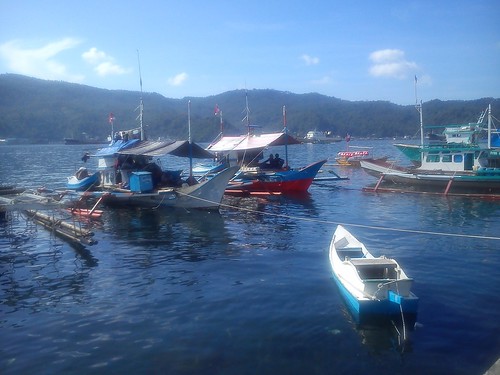 Small, outrigger fishing vessels at Bitung.
Small, outrigger fishing vessels at Bitung.
Nearby, one of these ungainly-looking craft was partly sunk with serious damage to the bow. Further along a similar boat had completely sunk in the shallow water and turned onto its side. The wreck was being broken up as watched. Parked at the edge of the quay was a flatbed lorry with a ‘Ferrari 717’ crane together with a high-sided lorry to receive the smaller debris. This was the extent of the automation. Otherwise, there was a cheerful group of men and women working away at the removal process. Most of the men were wearing pale blue polo shirts embroidered ‘OCEANIC FISHING PORT OF BITUNG’. Half of the men were standing chest-deep in the water and wearing face masks, occasionally disappearing underwater to attach a rope or break off some smaller part. One man had a small round net attached to a long pole and he was ‘fishing’ for smaller debris from the quay. Periodically, the group of laughing women would use handbrushes and pans to remove the small pieces that had fallen onto the quay. Fascinated by this good-natured operation, I returned to the bus rather reluctantly as the retrieval crew were using the lorry crane to rip-off a large section of the wheelhouse.
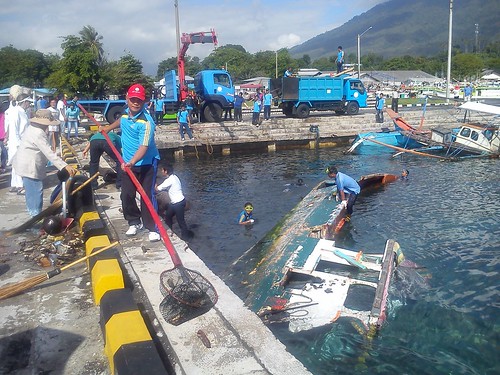 Recovering a wrecked boat.
Recovering a wrecked boat.
I hadn’t noticed before that the logo on the side of our coaches read ‘Visit Indonesia – Visit the Land of Smilling People’ (stet). Their English is still much better than my Indonesian. As we left the docks, we passed the fleet of large, steel ocean-going trawlers and saw the separate facility for handling container ships.
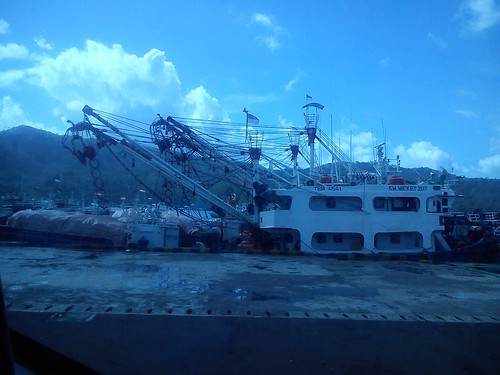 Deep-sea fishing vessels at Bitung.
Deep-sea fishing vessels at Bitung.
The roads in Bitung were very busy and it took us some time to reach the local market we were to visit. It took a few minutes for all the buses to find places where they could park off the carriageway without stopping all the traffic whilst we walked through a network of side streets with shops and market stalls on both sides of the road. Large numbers of Honda mopeds slowly pushed their way through the crowds of shoppers. Our arrival created great interest but, as elsewhere, all the people were very friendly.
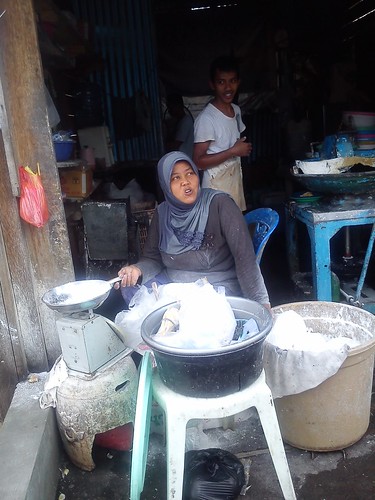
A glimpse of Bitung Market.
We continued out of the city but speeds did not improve much since there were a few places where the road was flooded. After travelling on smaller roads for a time, we reached our destination, the village of Sawangan. It took a while to manoeuvre our coaches through the gates of the Christian school we’d come to see. A large choir of boys and girls were waiting on the steps of the main building and, conducted by their headmistress, they delighted us with their singing. Afterwards, the passengers distributed ‘goody bags’ provided by the ship to the children.
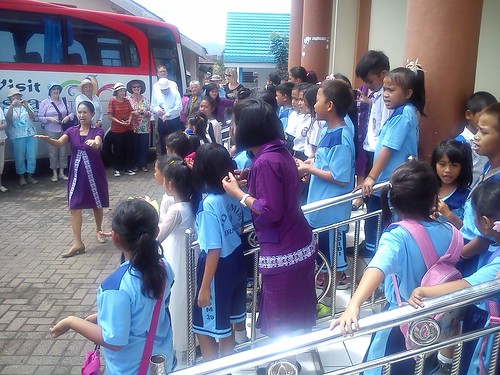 At Sawangan Christian School, the children sang for us.
At Sawangan Christian School, the children sang for us.
We then walked through the village to a covered performance area with seats with an ancient water cistern on one side and a ‘graveyard’ on the other. Five musicians in traditional dress played wooden xylophones and later a pretty young woman sang. Then a group of young men and young women dancers performed for us.
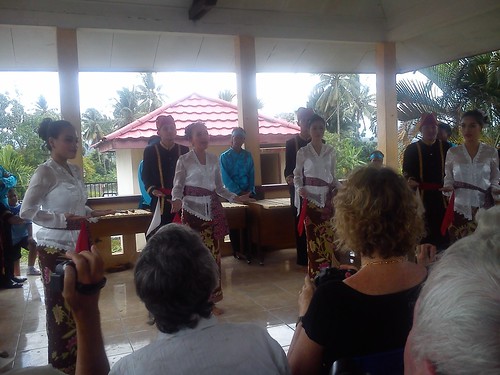 Dancers in traditional dress performing for the passengers.
Dancers in traditional dress performing for the passengers.
The large number of ‘Destination Asia’ staff in attendance distributed refreshments to us whilst the dancers changed into modern dress – colourful ballroom dresses for the girls and vaguely ‘Toreador’ style for the boys. After they had danced, they invited passengers to join in the performance. All these activities were keenly watched by a number of local people, especially the children.
We then walked around the ‘graveyard’ where the bodies are placed in Waruga stone sarcophagi standing on the ground, not buried. Here, we were joined by a large number of young people, in jeans and blue polo shirts, apparently part of a tourism initiative. Most of them had mobile phones/cameras and were keen to be photographed with the foreigners and, as always, there was a lot of smiling. By this time, our coaches had moved to a nearby street where we re-boarded for the journey back to Bitung and lunch on the ship.
 The covered performance area viewed from the 'graveyard'.
The covered performance area viewed from the 'graveyard'.
Afternoon: Tangkoko Nature Reserve
A little after 2.00 p.m. we joined our coaches for our excursion to Tangkoko Nature Reserve (see more about the Reserve here). We were to be taken on a forest trek by the Nature Reserve Rangers with the hope of seeing the rare Spectral Tarsier (Tarsius Tarsier) monkey. We made the usual slow progress out of the city using the road we’d already traversed twice going to and from Sawangan. Then we made a right turn onto a narrow road leading up into the hills. As well as narrow, the road was very twisting and steep, usually climbing but sometimes swooping down again, giving a rather edge-of-seat ride. For most of the journey it was also raining. In general, we were passing through rainforest but, occasionally, plots had been cleared for dwellings or small palm plantations.
 Rainforest with a clearing near the road.
Rainforest with a clearing near the road.
After around an hour, the coaches suddenly stopped. We disembarked and walked to the entrance of the Nature Park. Inside, we were distributed amongst a number of cars and people carriers (all carefully carrying ‘Noble Caledonia’ labels inside the front window) for the journey into the park. This road was unsurfaced, twisting and turning through ancient trees and splashing through flooded sections. It made the coach ride across the hills earlier seem quite tame by comparison. I was quite relieved when we stopped and were able to get out. We’d stopped in a small turning/loading area near a building marked as a Research Station. We could hear the sea nearby but not see it. After a short delay, we were divided into groups of ten, each with a Ranger in the lead and an assistant in the rear, and set off into the forest.
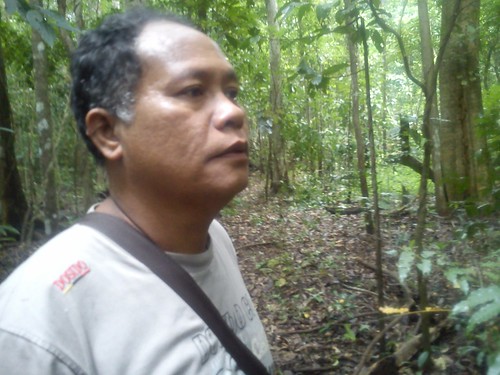 Our Ranger.
Our Ranger.
The trail was marked with coloured fabric ties on saplings every few yards. We weaved our way uphill amongst the venerable trees up to 200 years old, small roots threatening to trip-up the unwary.
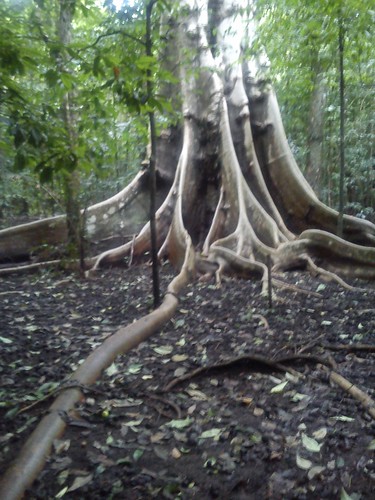
"... amongst the venerable trees up to 200 years old ..."
Our arrival had been timed to be near dusk, because the Tarsius Tarsier monkey we hoped to see is a nocturnal creature and only appears as it becomes dark, to hunt for food – typically insects like grasshoppers. There were a few sightings of other wildlife as we made our way to a massive, old hollow tree known to be occupied by the creature we hoped to see. It seemed a bit unkind to shine lights into the hollow tree, followed by a series of bright camera flashes as everybody tried to secure their own picture, but we all saw one or more of the attractive primates, with their huge eyes staring apparently unconcernedly at the intruders.

My rather inadequate shot of a Spectral Tarsier inside the hollow tree.
.jpg) The same Spectral Tarsier (Photo: Lea McQuillan).
The same Spectral Tarsier (Photo: Lea McQuillan).
We trekked back to the Research Station where snacks and cold drinks had been laid out for us. Some of us walked the few yards to the beach to watch the sea in the gathering gloom.
 The beach adjacent to the Research Station.
The beach adjacent to the Research Station.
The vehicles we’d arrived in had to make more than one round trip to the main gate to return everybody to the coaches, so there was a bit of waiting around. By the time we were all back on the coaches, I was very tired and I slept fitfully as we made our way back along the winding road. Once on the main road back to Bitung, we made better time as the evening traffic was lighter than during the day. Back at the port, I staggered up the gangway of 'Caledonian Sky' and hastily showered. Revived somewhat, I enjoyed an excellent dinner in the restaurant after a very memorable day.
On to Bunaken
A little before 10.00 p.m. we cast off on our overnight journey to Bunaken, just 57 nautical miles away. I’ll tell you a little about our visit to Bunaken next time.
You can find all the posts on this trip here.
My pictures
Arriving at Bitung, Sulawesi.
Bitung, Sulawesi - City Tour & Sawangan Village.
Tangkoko Nature Reserve, Sulawesi.
[Minor revisions, pictures and links added 2-Mar-2015, 3-Mar-2015]
